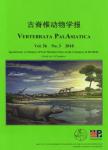Dentition of Subengius mengi (Mammalia: Plesiadapoidea) and a reassessment of the phylogenetic relationships of Asian Carpolestidae
Dentition of Subengius mengi (Mammalia: Plesiadapoidea) and a reassessment of the phylogenetic relationships of Asian Carpolestidae作者机构:Biodiversity Institute University of Kansas Lawrence KS 66045 USA Department of Ecology and Evolutionary Biology University of Kansas Lawrence KS 66045 USA Key Laboratory of Vertebrate Evolution-and Human Origins of Chinese Academy of Sciences Institute of Vertebrate Paleontology and Paleoanthropology Chinese Academy of Sciences Beijing 100044 China Division of Paleontology American Museum of Natural History New York NY 10024 USA Department of Anthropology Northern Illinois University DeKalb IL 60115 USA
出 版 物:《古脊椎动物学报》 (Vertebrata Palasiatica)
年 卷 期:2016年第54卷第3期
页 面:181-211页
核心收录:
学科分类:0710[理学-生物学] 07[理学] 09[农学]
基 金:国家重点基础研究发展计划项目(编号:2012CB821900)和美周国家科学基金(编号:BCS-0820602)资助
主 题:Paleocene Gashatan Plesiadapiformes biogeography phylogeny
摘 要:New fossils pertaining to the oldest known Asian plesiadapiform, the Gashatan carpolestid Subengius mengi, clarify aspects of the dental anatomy of this taxon. The dentition of S. mengi is substantially more primitive than previously recognized in retaining a lower dental formula of 2.***.3.3, a low-crowned p4 with three main cusps that are less fully connate than their counterparts in species of Elphidotarsius, P3 with a narrower and structurally simpler lingual margin, and in lacking widely splayed paraconid and metaconid on ml. The unique structure of P3 in S. mengi and a reassessment of P3 anatomy in Elphidotarsius sp., cf. E. florencae, suggest that certain cusp homologies on P3 in Carpolestidae have been misinterpreted in the past. Following a detailed character analysis, the phylogenetic relationships of carpolestids and their close relatives are reconstructed. The Bumbanian taxon Chronolestes simul is recovered as the most basal member of Carpolestidae. S. mengi and a second Bumbanian taxon, Carpocristes oriens, also appear to be relatively basal members of the carpolestid radiation, although none of these Asian carpolestid taxa seems to be specially related to each other. Dispersal of carpolestids between Asia and North America appears to have been restricted to earlier parts of the Paleocene, although carpolestids survived on both continents until sometime near the Paleocene-Eocene boundary.



